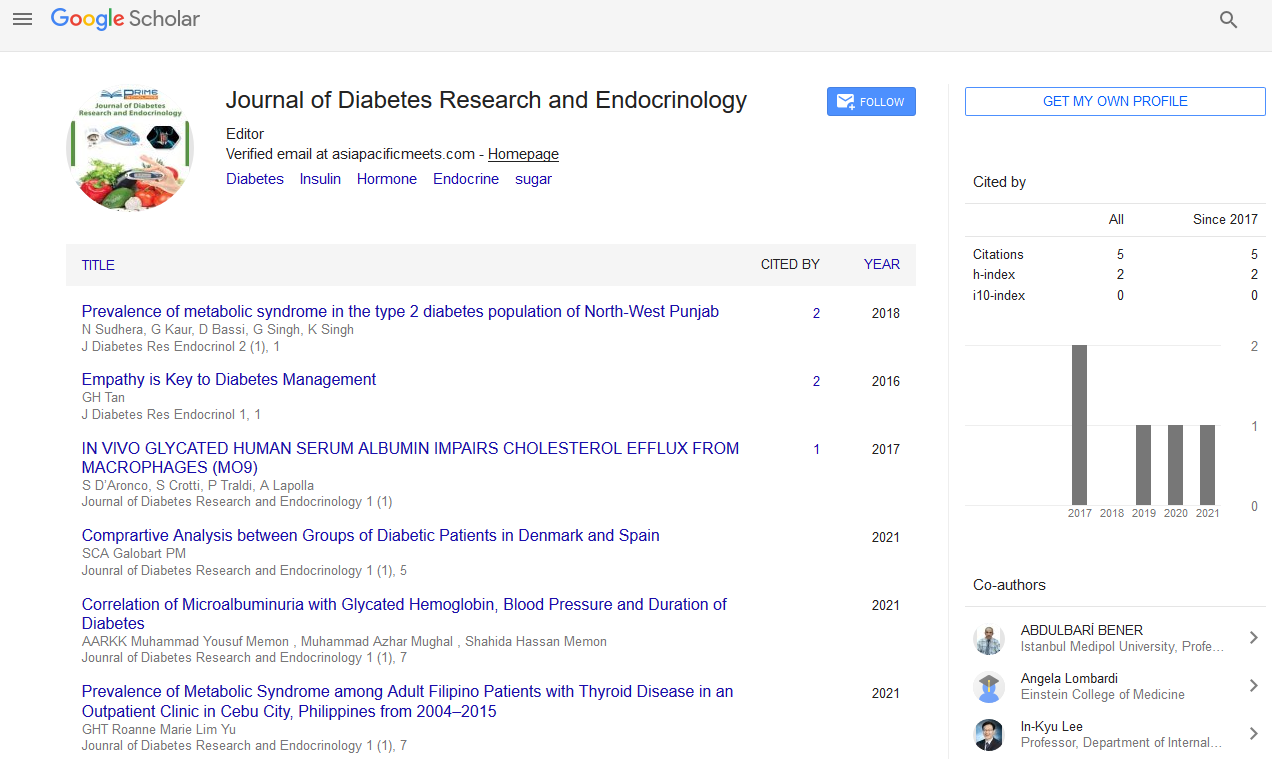Opinion - (2024) Volume 8, Issue 1
Advances in Islet Cell Transplantation for Type 1 Diabetes
Daniel Hughes*
Department of Endocrinology, Buckingham University, UK
*Correspondence:
Daniel Hughes,
Department of Endocrinology, Buckingham University,
UK,
Email:
Received: 28-Feb-2024, Manuscript No. IPJDRE-24-20066;
Editor assigned: 01-Mar-2024, Pre QC No. IPJDRE-24-20066 (PQ);
Reviewed: 15-Mar-2024, QC No. IPJDRE-24-20066;
Revised: 20-Mar-2024, Manuscript No. IPJDRE-24-20066;
Published:
27-Mar-2024, DOI: 10.36648/ipjdre.08.01.10
Introduction
Type 1 diabetes (T1D) is a chronic autoimmune condition
characterized by the destruction of insulin-producing beta
cells in the pancreas, resulting in the inability to regulate blood
sugar levels. While insulin therapy has long been the standard
treatment for T1D, it does not fully replicate the precise control
of blood glucose levels that is achieved by the body’s natural
insulin production. Islet cell transplantation has emerged
as a promising alternative therapy, aiming to restore insulin
independence and improve quality of life for individuals with
T1D. In recent years, significant advancements in islet cell
transplantation techniques, immunosuppression protocols,
and long-term outcomes have brought renewed hope to the
T1D community. Islet cell transplantation involves the transfer
of insulin-producing islet cells from a donor pancreas into the
recipient’s liver. These transplanted islet cells are then able to
produce and release insulin in response to changes in blood
glucose levels, effectively restoring glycaemic control. One of
the critical challenges in islet cell transplantation has been
the isolation of high-quality islet cells from donor pancreases.
Recent advancements in enzymatic digestion techniques and
purification methods have significantly improved the yield and
viability of isolated islets, leading to better transplantation
outcomes.
Description
While the liver has traditionally been the primary site for islet
cell transplantation, researchers are exploring alternative
sites, such as the momentum (a fatty tissue in the abdomen)
and the subcutaneous space. These alternative sites offer
advantages such as a more favourable microenvironment
for islet survival and function, as well as easier access for
monitoring and potential repeat transplantations. To prevent
rejection of transplanted islet cells, recipients typically require
lifelong immunosuppressive therapy. Recent advances in
immunosuppression protocols have focused on minimizing the
side effects associated with these medications while maintaining
adequate protection against rejection. Novel approaches, such
as the use of anti-thymocyte globulin (ATG) and monoclonal
antibodies targeting specific immune cells, have shown
promise in improving transplant outcomes while reducing the
risk of complications. Encapsulation involves enclosing islet
cells in a protective barrier to shield them from immune attack
while allowing the exchange of oxygen, nutrients, and insulin.
Advances in biomaterials and bioengineering techniques have
led to the development of more biocompatible and durable
encapsulation devices, offering the potential for long-term
graft survival without the need for immunosuppression. Recent
clinical trials and observational studies have demonstrated
encouraging results with islet cell transplantation, including
improvements in glycaemic control, reduction in severe
hypoglycaemia, and enhanced quality of life. However,
challenges such as donor shortage, immune rejection, and
the need for lifelong immunosuppression remain significant
barriers to widespread adoption.
Conclusion
Regenerative approaches, such as promoting endogenous
regeneration of pancreatic beta cells or modulating the immune
system to induce tolerance to transplanted cells, offer potential
alternatives to traditional transplantation methods. Research
in regenerative medicine holds the promise of restoring natural
insulin production in individuals with T1D without the need for
exogenous insulin therapy. Advances in islet cell transplantation
hold great promise for individuals with type 1 diabetes,
offering the potential for improved glycaemic control, reduced
hypoglycaemia, and enhanced quality of life. While significant
progress has been made in islet isolation, transplantation
techniques, and immunosuppression protocols, ongoing
research and innovation are needed to address remaining
challenges and optimize long-term outcomes. With continued
advancements in stem cell technology, xenotransplantation,
and regenerative medicine, islet cell transplantation is poised
to play an increasingly important role in the management of
type 1 diabetes in the future.
Citation: Hughes D (2024) Advances in Islet Cell Transplantation for Type 1 Diabetes. J Diab Res Endocrinol. 8:10.
Copyright: © 2024 Hughes D. This is an open-access article distributed under the terms of the Creative Commons Attribution License, which permits unrestricted use, distribution, and reproduction in any medium, provided the original author and source are credited.

